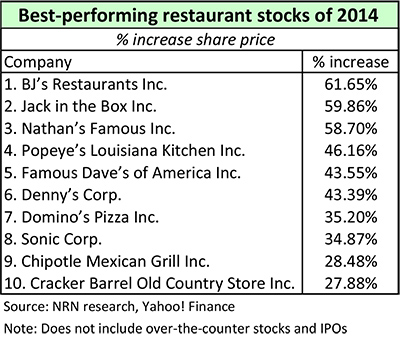The restaurant industry couldn’t keep up with a surging stock market in 2014, as weakness at several large brands and a perception that many companies are at peak valuations kept stock prices at bay.
The NRN Restaurant Index finished the year up 3.58 percent. By comparison, the S&P 500 index finished the year up 11.4 percent, and the NASDAQ finished the year up 13.4 percent.
More restaurant stocks underperformed the S&P 500 than did those that outperformed the index. Some of the year’s losers included some of the industry’s biggest companies, including its two largest: McDonald’s Corp., whose stock fell 3.43 percent on weak sales worldwide, and Yum! Brands Inc., whose stock declined 3.65 percent on weakness in China, its biggest market.
 But winners easily outnumbered losers on the year, and many chains attracted investors in droves.
But winners easily outnumbered losers on the year, and many chains attracted investors in droves.
BJ’s Restaurants Inc. was the top-performing restaurant stock on the year, excluding chains that trade over-the-counter and those that went public in 2014.
BJ’s finished the year up 61.65 percent, as the Huntington Beach, Calif.-based casual-dining chain’s sales returned to positive territory, following weakness in prior years that had turned investors against the concept.
Jack in the Box Inc. was the top-performing quick-service restaurant company, finishing the year up 59.86 percent, due to a combination of solid performance by its flagship brand and strong sales growth at its fast-casual Qdoba Mexican Grill concept.
The best-performing fast-casual chain was Chipotle Mexican Grill Inc., which finished the year up 28.48 percent. That performance came during a year in which same-store sales rose 17 percent during its first three quarters.
Chipotle started the year trading at nearly $533 per share and finished at $684.51 per share, defying expectations that it would ultimately come back down to earth after years of astounding growth interrupted only by the recession.
Chipotle’s strong performance piqued interest in IPOs in 2014, driving values sky-high as investors bet that one of them would ultimately replicate the performance of the Denver-based burrito chain.
In fact, three IPOs would have been the top-performing restaurant chain on Wall Street had they traded for the full year. Zoe’s Kitchen Inc.’s stock price finished the year at $29.91 per share, nearly double its $15 offering price. Likewise, The Habit Restaurants Inc. finished the year at 79.72 percent above its offering price. And Dave & Buster’s Entertainment Inc.’s stock finished the year at 70.63 percent above its IPO.
The challenge for each of those companies is to maintain investor interest over time. So far, relatively few operators that have gone public in the post-recession environment have done so. Of the 15 chains whose stock prices declined in 2014, seven of them have gone public since 2010.
Potbelly Inc. was among the worst-performing stocks in 2014, after a 46.54-percent decline, as sales weakness irked investors and wiped out the gains the operator realized shortly after its IPO in October 2013. Potbelly is now trading below its $14 offering price.
Another weak performer this year was Chuy’s Holdings Inc., the Austin, Texas-based Mexican casual-dining chain that debuted on Wall Street in 2012. The company saw a strong valuation after its IPO, but weak earnings this year brought the stock down to earth. The company went public at $13 per share, and has been as high as $43 per share, but finished at just $19.88 per share, a decrease of more than 45 percent.
Sales in 2015
(Continued from page 1)
The problem some recent IPOs have experienced is due to their early valuations. Companies generate considerable enthusiasm when they go public. Investors bid the stocks up, giving them valuations that prove difficult to maintain over time.
Noodles & Company, a Denver-based fast-casual chain that employs some former Chipotle executives, finished down 26.64 percent on the year, but is still trading at $26.35, more than 46 percent above the $18 offering price from its 2013 IPO. Like other chains, disappointing sales were the primary culprit for the decline this year.
Much like those IPOs, high valuations likely tempered performance of restaurant industry stocks.
The industry saw a banner year in 2013: Restaurant stocks surged an average of 45 percent amid prospects for an improving economy. As a result, many companies entered the year with strong valuations, which gave them less room for growth and higher expectations from investors.
Despite a mediocre 2014, all but 10 restaurant chains are trading at enterprise value multiples of more than 10 times earnings. The enterprise value is the price at which a company would fetch in an acquisition, and a double-digit multiple for a restaurant company often prices out many potential buyers, like private-equity groups.
But with low gas prices and strong employment expected to boost sales in 2015, some analysts say the coming year could prove better for restaurants on Wall Street.
“We cover 16 stocks,” said Janney Capital Markets analyst Mark Kalinowski. “We have ‘Buy’ ratings on the majority of them. That speaks for itself.”
Contact Jonathan Maze at [email protected].
Follow him on Twitter: @jonathanmaze

